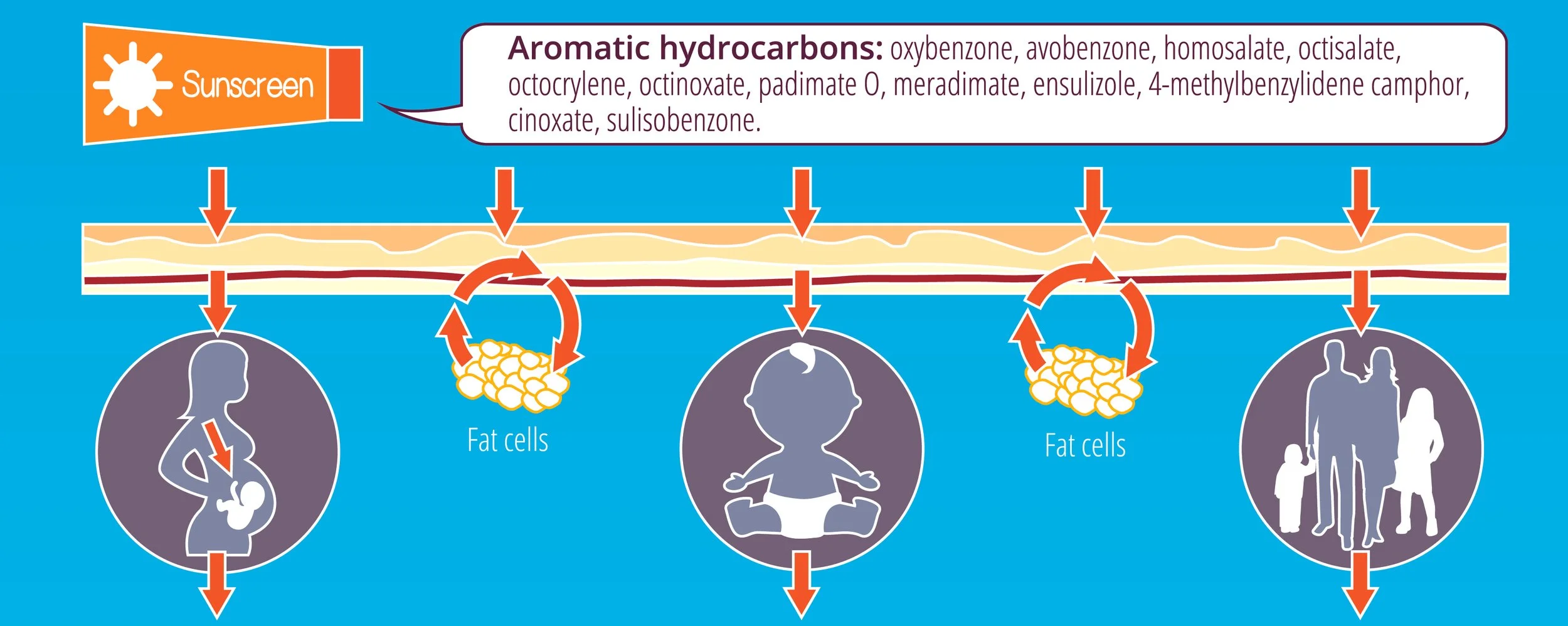SUNSCREENS USING SOLUBLE AROMATIC ORGANIC UV FILTERS SHOULD BE STRICTLY AVOIDED IN PREGNANCY
The fetus is the most vulnerable human. The entire pregnancy is susceptible to external agents- viral or chemical - disrupting normal fetal development at many levels. Embryonic and fetal life in the first trimester is the most crucial period but any insult up to 20 weeks may affect anatomic, hormonal, and neurological development, or any organ system. Effects are usually more serious and irreversible when they occur in early pregnancy.
Twelve soluble aromatic UV filters have been watchlisted by the US FDA and are all to be banned in Hawaii to protect the coral and marine wildlife, unless the US FDA eventually designates them as SAFE and EFFECTIVE. All pass through human epidermis to attain tissue levels and bathe every cell in the body. They are fat soluble and will bio-accumulate in tissue over time. They even cross the Blood Brain Barrier of your unborn or young child. Studies confirm the widespread contamination of humans with soluble UV filters found in blood, urine, amniotic fluid, placenta, fetal and cord blood, semen, ovarian follicular fluid, and adipose tissue. The entire global water supply, terrestrial, aquatic and marine biota are all polluted with these petrochemical UV filters. An evidenced based analysis based on this pervasive contamination supports the contention that soluble UV filters may have become the leading source of exposure to hormone disruptors, particularly in developed countries where sunscreen use is highest. Adult exposure to a chemical or hormone disruptor may have very different consequences from fetal or infantile exposure.
Twenty five years of science prove bioavailability of UV filters to humans and wildlife, recently confirmed by FDA studies to achieve levels exceeding the FDA threshold for toxicity testing. The FDA reiterated the concern in 40 years of scientific literature for hormone disruption and other adverse effects in wildlife and humans. They list 12 of these soluble hydrocarbon UV filters as having insufficient data to consider them Generally Regarded As Safe or Effective (GRASE). These include avobenzone, oxybenzone, homosalate, octisalate, octocrylene, octinoxate, meradimate, cinoxate, padimate O, ensulizole, dioxybenzone, and sulisobenzone. Only the INSOLUBLE inorganic mineral UV filters zinc oxide and titanium dioxide have the evidence to support the positive GRASE category given by the FDA.
Regardless of the risks, the mere fact of bioavailability to the fetus and their presence in breast milk should be reason enough to avoid them during pregnancy and nursing. I urge every consumer to avoid them completely. Recent scientific literature confirms the same pattern and prevalence for adverse effects in humans and wildlife from organic UV filters. They also pollute the water supply and the food chain. Ingestion becomes a secondary route for human contamination. This is of particular concern when exposure occurs pre-conception, during pregnancy or nursing, in infancy and childhood, and adolescence or puberty. Serum and urine sampling provide a “snapshot” but may not assess the persistence of a UV filter in cells of adipose and important human tissue e.g. the brain. Testing after limited application of UV filters in some studies cannot measure relevant long-term or lifetime levels in assessing human toxicity.
There is no real evidence that these soluble petrochemical UV filters can or actually prevent skin cancer. Their use over 60 years is paralleled by sharp increases in all forms of skin cancer, particularly in young adults, more so in females. Since there is no defined benefit provided by sunscreens using these filters, then unintended human and wildlife toxicity become more significant. Definitive fetal toxicity studies to identify mutagenic, epigenetic effects, or to assess the NOAEL (No Observed Adverse Effect Level) in a fetus are either unethical, impractical, and close to impossible. The Benefit Risk Assessment for soluble organic UV filters have little benefit to the mother in discernible population based reduction of skin cancer for the mother and has only risk to the fetus and no intended benefit.
For all of the reasons listed above, but even from the position that prudent people will usually exercise an abundance of caution- especially where your children are concerned – we believe that all consumers should strictly avoid using these bioavailable filters. At very least, they are best avoided during pre-conception, pregnancy, and nursing – in my opinion they are absolutely contraindicated during pregnancy and nursing. Until a WARNING Label appears on these undesirable sunscreens about BIOAVAILABILITY for all consumers, with a special CAUTION to pregnant or nursing mothers and others who may be more vulnerable, please enforce your own AVOIDANCE. The alternative – use sunscreens with large molecular weight INSOLUBLE filters – inorganic zinc oxide, titanium dioxide, organic bemotrizinol, bisoctrizole, and drometrizole trisiloxane, which exceed the 500 Dalton threshold for permeation through human skin. This avoids the bioavailability underlying any risks for the adverse effects seen with SOLUBLE petrochemical UV filters. These insoluble filters include the most efficient UVA filters and provide better balanced UVA/UVB protection against skin cancer and keeps you looking younger for longer. More BENEFIT– virtually ZERO RISK. The Precautionary Principle applied - and a better Benefit Risk equation for humans, wildlife and the environment.
© Denis K. Dudley MD, JUNE 2019. All rights reserved.

